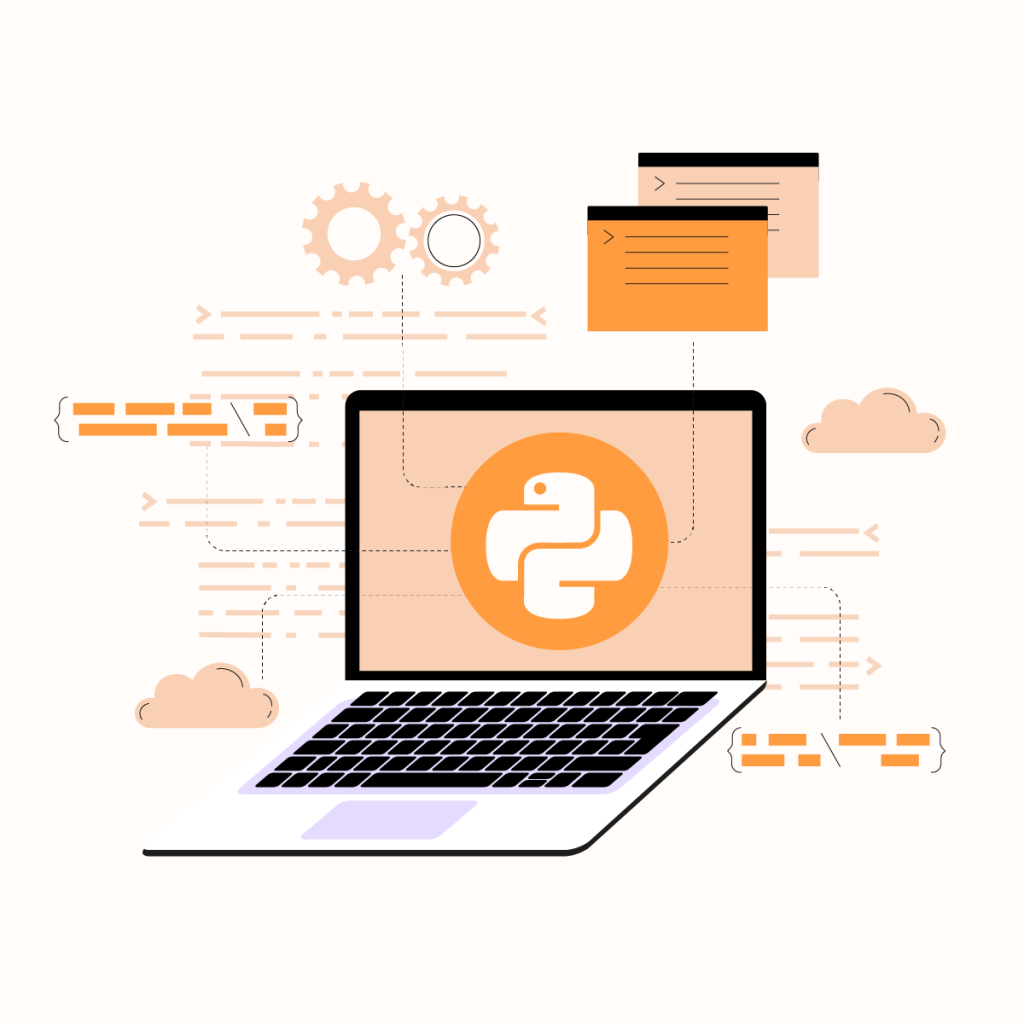Introduction
The demand for data has never been more pressing. Information is critical in today’s world as businesses thrive on data to make decisions. Therefore, the ability to extract data from the web has become a cornerstone for many organizations. The internet is home to a vast amount of information that can give your business a competitive edge. Leveraging the potential of Python service opens up a world of new possibilities for data informed decisions.
If you are a business owner or manager, you may be wondering how to optimize web data extraction. The solution is utilizing proxies– which act as a middleman between your device IP address and the website.
This article will explore Python service and how to integrate it with Netnut for unmatched web data retrieval activities.
Why Does My Business Need Web Data?
Before we dive into the technical aspects of Python service in web data extraction, it is essential to understand the significance of getting web data. The web contains various information, including market trends, social media strategies, consumer behavior, pricing, and more. Therefore, data collection, analysis, and organization have become a cornerstone in helping businesses make informed decisions and stay ahead of the competition.
Here are some of the significance of gathering web data:
- It helps to stay abreast of past and recent market trends. The market is constantly evolving, so companies need access to data to make strategic decisions.
- Consumer behavior data can help businesses optimize prices to increase profit and maintain a competitive edge.
- In addition, it helps businesses to understand better consumer needs and the best marketing strategy to keep customers coming back.
- Trend identification from data allows organizations to predict risk and place strategies to mitigate such situations.
Relationship Between Python Service and Web Data Scraping
Most times, when people hear the word “python,” they think of the large venomous snake or the programming language (tech-savvy folks). However, Python is a simple and versatile option for efficient data extraction services. Integrating Python service into data extraction optimizes the process to deliver reliable results.
Benefits of using Python Service
- Vast ecosystem: One of the benefits of using Python service is the availability of resources, including libraries that can assist with web data scraping
- Flexible compatibility: Since Python is a programming language, it can be used across various platforms. If your device is MacOS, Windows, or Linux, you can use Python service. Therefore, the use of Python service ensures flexibility in accessing data without limitation to the device operating system.
- Automation: Another significant benefit of Python service is automation. Data scraping activities can be a constant event, especially for an organization that needs to stay updated. Therefore, with the Python service, a script for automation can be designed to extract data at various intervals.
- Data structuring: Another excellent feature of Python is the HTTPS libraries. They play a significant role in cookie settings, authentication, and a range of data scraping to optimize the process of data collection.
- Robust community: Python service have a large community of experts and enthusiasts. Therefore, you can always find relevant information, answers, and videos to assist with data scraping.
- Customization: Python service can be customized to retrieve data at scheduled intervals so that your business always stays up-to-date with relevant information.
- Integration with proxy: Python service can be integrated with IP proxies to ensure anonymity and bypass IP-blocking services.
Fundamental concepts associated with Python service
Python, a programming language, is a complex concept. However, it is critical to understand some of the basic concepts regarding Python service. These concepts will be involved in using Python service for data extraction. They include:
HTTP- HyperText Transfer Protocol
HTTP is a stateless protocol used for transferring files like text, sound, video, and other files. It opens a connection and sends a message (interaction between client and server) to an HTTP server. The server responds and closes the connection.
Components of HTTP
HTTP request: This is the method of communication between web browsers and the website. Each HTTP request has some encoded data that carries information. HTTP request typically includes:
- HTTP version type: There are four versions, which include HTTP/0.9, HTTP/1.0, HTTP/1.1, and HTTP/2.0.
- A URL: A uniform resource locator, also called a web address, is a unique identifier.
- HTTP method: This is the action that the HTTP request expects from the queried server. For example, a “GET” request expects information back from the website.
- Request headers: HTTP request headers contain text in key-value pairs. They are involved in all HTTP requests and contain significant information, such as the client’s browser.
- HTTP body (optional): This part contains the body of data that is transferred by the request. Most times, it includes information submitted on a website like username or email.
Why Do You Need Proxies?
Web scraping is a unique method that allows for the collection of data from the internet. The data is then stored in a local file for analysis and interpretation. You can scrape data from any website with the right software.
Another critical aspect of extracting data from the web is proxy servers. They act as the intermediary between your device and the website. In other words, they hide your original IP address and location. This function is highly relevant because it protects you from advertisements and being kicked out of the website. In addition, the use of residential proxies offers extra security by encrypting the data as it moves between the server and your device.
There are some challenges to extracting data from various websites due to pre-programmed restrictions. For example, some websites block IP addresses within some regions. Therefore, if you are within these regions, you cannot access the website for data extraction. However, with proxies, you can change your location, access the data, and seamlessly extract it.
Some websites block IP addresses that are known for scraping data. However, with rotating residential proxies, you can distribute the data scraping activities across various IP addresses and accelerate the rate of data extraction. As a result, the process of scraping data becomes faster and more efficient.
Integrating Python Service with a Proxy
This section shall examine how to integrate a proxy with a Python service. Bear in mind that you need to create a new Python project on your computer to run the scripts customized for web scraping.
Before we dive into integrating a proxy with Python service, it is essential to understand the things that make up a proxy. There are three major components of a proxy, and they include:
- Protocol: This is the determinant of the type of content you can access on the web. HTTPS and HTTP are the most common protocols.
- Address: The address indicates the location of the proxy server. It could be an IP address such as 192.167.0.1 or a DNS hostname like “proxyprovider.com”.
- Port: The unique function of the port is to direct traffic to the right server. For example, port number 2000.
Combining these three components gives you an idea of what a proxy IP address should look like. It could be like “192.167.0.1: 2000″ or “proxyprovider.com: 2000″.
Follow the steps below to get started:
A. Install python packages/libraries
The first step is to create a directory to store the source code files. Data scraping with Python service not only extracts the information but the source codes as well. The next step is to install specific Python packages that will assist you in the process of data collection.
One of the advantages of using Python service for web scraping is the vast selection of libraries. Although there are various types of python web scraping libraries, let us look at some of them:
-
Requests library
This package sends HTTP requests to the website you intend to extract their data. Once the package is running, the HTTP request returns a response object with all the response data, including encoding, status, encoding, and more.
Getting data from the web begins with HTTP requests like “Post” or “Get” to the website, which returns a response containing the data. One of the challenges of using Python HTTP libraries is the difficulty of using them because they often require bulky lines of code. However, the request library simplifies this problem by using less bulky codes, which are easier to understand and implement. Run the “pip install request” command to install the request package on your device.
In addition, it is easy to integrate proxy servers with request packages. With the following command, the Python service can use proxies that require authentication.
proxies={‘http’: ‘http://user:password@pr.netnut.io:7777’}
response = requests.get(‘https://ip.netnut.io/’, proxies=proxies)
print(response.text)
Regardless of the benefit of simplicity that comes with the request package, it has a limitation. This library does not parse the extracted HTML data. In simpler terms, it cannot convert data scraped from the internet into a readable form ready for analysis.
Another limitation of the request library is that it is not compatible with websites that were programmed solely with JavaScript. As a result, you cannot scrape data from these websites with the request package.
-
Beautiful Soup
Beautiful Soup is a powerful Python library that plays a significant role in web data scraping. Run the command “pip install beautifulsoup4” to install the package on your device. Beautiful Soup provides simplified solutions for navigating and modifying a DOM tree.
In addition, beautiful Soup is an excellent choice that parses XML and HTML documents. Moreover, it can convert an invalid markup into a parse tree. Therefore, it offers you the flexibility of implementing various parsing strategies. Alternatively, this package allows you to trade speed for flexibility. If you need to parse any data on the web, Beautiful Soup will do an excellent job.
Beautiful Soup is limited because its unique function is parsing data. Therefore, it cannot be used to request data from the internet. As a result, it is often used together with the Python Request Package.
Since Beautiful Soup makes it easy to navigate and modify the parse tree, it is ideal for beginners. Also, expert developers opt for this library because it saves them several hours. For example, if you want to print all the blog titles on a web page, you can use this command:”find_all ()”
Another unique function of this library is broken HTML parsing. In addition, Beautiful Soup can detect page encoding, which further optimizes the authenticity of data extracted from the HTML file.
Furthermore, you can customize Beautiful Soup with a few lines of code to identify and extract specific data.
-
lxml
This powerful and easy-to-use parsing python library is compatible with XML and HTML files. Consider lxml when you desire to extract data from large datasets. Its parsing capabilities are limited compared to Beautiful Soup, which can be attributed to poorly designed HTML.
You can install the lxml library using the command: “pip install lxml.”
Although the library contains an HTML module, it still requires the HTML string. The string can be gotten with the Request package. Once the HTML is available, the parse tree can be programmed using the “fromstring” command. For example:
# After response = requests.get()
from lxml import html
tree = html.fromstring(response.text)
-
Selenium
Remember, we mentioned that some websites were developed using JavaScript, which poses a problem for Python packages like the Request library. Some developers choose to use JavaScript because it allows them to create some unique functionality on the web page. Therefore, Selenium becomes a unique solution when you need to scrap data from these websites with python service.
Selenium is an open-source browser automation tool that automates various processes, such as logging onto a website. It is often used to execute test scripts on web apps. One of its unique features is the ability to initiate web page rendering.
To use Selenium for data extraction, you need three things. The first is the selenium library, which you can install with the pip command: “pip install selenium.” Another requirement is supported web browsers like Firefox, Chrome, Safari, and Edge. Lastly, you would need drivers for the browser.
After installing the Selenium package, the driver for that specific browser can be imported. For example, if you want to use Selenium on Chrome:
from selenium import webdriver
from Selenium.webdriver.common.by import By
driver = webdriver.Chrome()
Another excellent feature of Selenium is that it interacts with data being displayed and makes it available for parsing with in-built methods or Beautiful Soup. Some developers love to use the Selenium library because it can imitate human behavior.
However, this Python library is limited in terms of the speed of data extraction. The speed reduction occurs because the package must first execute the JavaScript code for each page before preparing them for parsing. Therefore, there are better choices than Selenium for extracting large-scale data from various web pages.
However, Selenium is an excellent choice when you need to extract lower-scale data, or reduced speed is not a challenge.
2. Set proxy Directly in Request
To begin, the first step is to import the Request and Beautiful Soup packages that you initially installed. The next step is to create a directory named proxies to hold proxy server information that will hide your IP address when extracting data. Therefore, you need to define both the HTTPS and HTTP connections to the proxy server URL. Another component you need to define is the “Python variable,” which contains the URL of the website for data extraction.
Moving on, the next command is to send a “GET” request to the web page by utilizing the request get () method. This method involves the URL of the websites and proxy URLs. Then, responses obtained from the website are stored in the “responsible variable.”
At this stage, if you want to collect the links, you need to use the Beautiful Soup package. Beautiful Soup will parse the HTML content of the website by giving the command: “response.content and html.parser to the BeautifulSoup () method.”
To find all the links on a particular website, use this command: “find_all ().” In addition, you can use the () method to extract the href attributes.
NB: When you run the code, it sends a request to the website using the proxy IP address and returns the response, which contains all the links to the web page.
3. Set proxy with environmental variables
If you constantly need to get data from the web, you may use the same proxy for the different requests. However, you can automate it by setting environment variables for your proxy server.
To set the environment variables for the proxy whenever you run the Python scripts, input the command below into your terminal.
export HTTP_PROXY=’http://proxyprovider.com:2000′
export HTTPS_PROXY=’https://proxyprovider.com:2000′
NB: Once you set the environment variables, you do not have to worry about setting up proxies in the code. Therefore, as soon as you run the command to make a request, it gets automatically updated.
4. Using a custom method to rotate proxies
When an IP address makes a request to scrap a large amount of data, it may be flagged or blocked. This occurs when the website’s restrictive measures are triggered to prevent malicious data scraping. However, rotating proxies becomes paramount as they prevent this from happening.
Rotating proxies works by rotating various IP addresses to avoid being detected by the website. As a result, one IP address may appear as multiple so as to bypass anti-scraping measures programmed on the website.
How to get started:
- Import python libraries such as “Request,” “Beautiful Soup,” and Random.
- The next step is to create a list of proxies that you want to use for the rotation. It is crucial to arrange the URLs of the proxy servers in a specific format: http://proxyserver.com:port:
- Create a custom method called “get_proxy ().” The unique function of this method is to randomly select a proxy IP address from the list with the command “random.choice ().” The selected proxy is returned in both HTTPS and HTTP format.
For example:
# Custom method to rotate proxies
def get_proxy():
# Choose a random proxy from the list
proxy = random.choice(proxies)
# Return a dictionary with the proxy for both http and https protocols
return {‘http’: proxy, ‘https’: proxy}
After creating the get_proxy () method, the next step is to create a loop that sends a specific number of GET requests using the rotated proxy IP addresses. For every request, the get () method uses a randomly selected proxy gotten by the get_proxy () method.
An Alternative to Running Python Services for Web Scraping
With all the programming codes we have mentioned, you are probably doubting if Python service is the best option for your data scraping needs. The good news is that you don’t have to be a programming or Python expert to benefit from this service.
An alternative is the Netnut Scraper API- it automatically gathers data from web pages and integrates it with other software via API calls. In other words, this method automates the scraping process. As a result, it eliminates the need to run the Python codes manually whenever you need to extract data. Another bonus to using the Netnut Scraping API is that the data is always organized.
The Netnut Scraper API already has the codes designed for collecting data from websites. Therefore, you don’t have to worry about getting the instructions/codes right. You can use one API endpoint to collect data several times. This method is super simple, easy to use, and convenient. As a result, you have easy and convenient access to data whenever you need them.
Using the Netnut Proxy Service with Python
Are you a business owner or analyst in search of a reputable, fast, and reliable proxy for web data extraction? Look no further than Netnut, a platform that provides various proxies to cater to your specific data extraction needs. These proxies serve as an intermediary between your device and the website that holds the data.
Netnut has an extensive network of over 52 million rotating residential proxies in 200 countries and over 250,000 mobile IPS in over 100 countries, which helps them provide exceptional data collection services.
The various proxy solutions are designed to help you overcome the challenges of web scraping for effortless results. These solutions are critical to remain anonymous and prevent being blocked while scraping data from web pages.
Benefits of using Netnut proxies
While there are several challenges to extracting data from websites, you can rely on the industry-leading proxy network to transform any website into structured data.
Some of the benefits include:
- Zero IP block: Many websites have measures to block scraping activities. However, proxies help to bypass these measures.
- Unmatched global coverage: Easily adjustable settings to guarantee uninterrupted data extraction from any website in any location of the world.
- User-friendly dashboard: That allows you to monitor and adjust your proxies in real-time.
- Anonymity: Rotating residential proxies hides your actual IP address to ensure anonymity during data extraction. Therefore, Netnut proxies are less likely to be blocked by websites, which makes gathering global data more efficient.
Netnut proxies can be easily integrated with Python service to optimize the data extraction experience. We offer 24/7 online support to answer your questions and cater to your data scraping needs.
Sign up today to get started!
Conclusion
This article has explored the concepts of Python service and how they can be integrated to optimize web scraping. You need various Python packages such as Request, Selenium, and Beautiful Soup to get access to data on a website.
With the Netnut platform, you can get reliable proxies for your data extraction anywhere in the world. We offer various options to ensure your web data extraction needs are met. Proxies provide a solution to bypass IP blocks and geo-locked content.
Choosing the proper proxies for your needs, integrating them with Python service, making adjustments, and monitoring them in real time can optimize the process of web data extraction.
Whether you aim to gather social sentiment data, financial data, or monitor competitor’s prices, take advantage of the resources at Netnut to get it done efficiently.
Frequently Asked Questions
How Does Python Web Scraping Work?
Python web scraping is a method of extracting data from websites. The process involves making HTTP/HTTPs requests, HTML parsing, and extracting specific data from various web pages.
What Do I Need for Data Extraction Python Service?
Python service is an excellent option for data scraping because of its vast resources. Some of the packages or libraries you need for Python service include Request, Selenium, Beautiful Soup, xlml, and others.
What are the use cases for Python service?
The use of Python service in extracting data from various websites has applications in different industries. For example, extracted data can be used for price monitoring in e-commerce niches, competitor analysis in the marketing industry, and data analysis for financial and economic sectors. Other sectors include healthcare research, social media analysis, real estate market analysis, and retail optimization.





